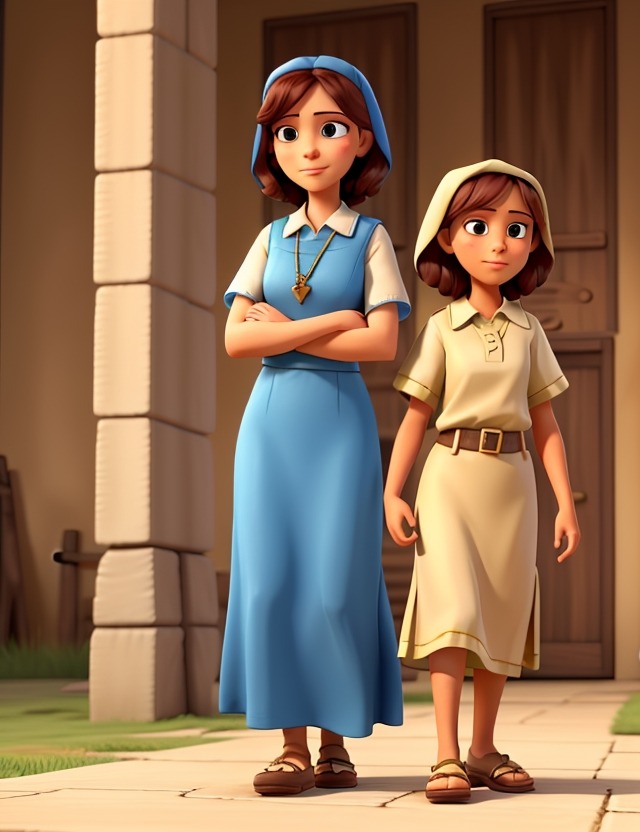Have you ever wondered how a timeless tale of friendship and loyalty, set in ancient times, can still resonate with us today? In “Ruth and Naomi,” a powerful biblical narrative, we are transported to a period filled with uncertainty, hardship, and unlikely alliances. This remarkable story not only showcases the strength of female friendship but also highlights the enduring value of loyalty and perseverance.
- Ruth and Naomi Story Summary
- Ruth and Naomi: Key Themes
- Ruth and Naomi: Characters
- Ruth and Naomi: Symbols
- Where Did Ruth and Naomi Live?
- Where Did Ruth and Naomi Travel To?
- Why Was Ruth So Loyal to Naomi?
- What Is Ruth and Naomi Relationship?
- Lessons from Ruth and Naomi
- Ruth and Naomi Story Bible Verse
- Ruth and Naomi: Culture Impact
- FAQs
Join us as we delve into the depth of this ancient parable, connecting its meaningful lessons to our modern lives. Prepare to be captivated by the tale of Ruth and Naomi, as we unravel their inspiring journey that transcends time, offering lessons that still hold true today. Discover the impactful lessons and timeless wisdom hidden within the pages of this extraordinary narrative, and unlock the heartwarming bond shared by two extraordinary women. Embark on a journey that will leave you inspired, enlightened, and eager to share their story with others.
Ruth and Naomi Story Summary
Ruth and Naomi in the Bible. Once upon a time, in a far-off land, there lived a family named Elimelech, Naomi, and their two sons, Mahlon and Chilion. They were happy and content living in Bethlehem, a beautiful town known for its fields of wheat and barley.
But one day, a terrible famine struck the land, and there was no food to eat. The family, fearful for their survival, decided to leave Bethlehem and journey to the land of Moab, where there was food. They packed their belongings and sadly said goodbye to their friends and relatives.
In Moab, they faced many challenges. They didn’t know anyone and felt like strangers in a strange land. However, they were grateful to find refuge and food to sustain them. Time passed, and both the sons grew up and married Moabite women named Orpah and Ruth, bringing new hope and joy to the family.
But life can be unpredictable, as Naomi soon discovered. Tragedy struck again when Elimelech died suddenly, leaving her a widow. She was devastated, but with the help of her sons and daughters-in-law, she found the strength to carry on.
Years slipped by, and tragedy struck once more when Mahlon and Chilion also passed away, leaving their young wives widowed. Naomi was heartbroken and burdened with grief. She felt like all hope was lost and decided to return to Bethlehem. She wanted to be with her own people, to find solace among her relatives.
Naomi, Ruth, and Orpah set out on their journey back to Bethlehem, their hearts heavy with grief and uncertainty. Along the way, Naomi began to worry about her daughters-in-law. She loved them dearly and wanted the best for them, but life in Bethlehem would be difficult for them as Moabite women. With a heavy heart, she suggested that they return to their families and find happiness elsewhere.
Orpah tearfully bid her farewell, understanding Naomi’s concerns and deciding to go back home. But Ruth, filled with love and loyalty for her mother-in-law, clung to Naomi, vowing to stay by her side no matter what. She uttered the famous words, “Where you go, I will go. Where you stay, I will stay. Your people will be my people and your God my God.”
Moved by Ruth’s devotion, Naomi accepted her and they continued their journey, hand in hand. The news of Naomi’s return spread through Bethlehem, and the townspeople were overjoyed. But Naomi, still grieving, said, “Do not call me Naomi, call me Mara, for the Almighty has made my life very bitter.” She felt that her life had been filled with sorrow and hardship.
Together, Naomi and Ruth settled in Bethlehem and began to rebuild their lives. They were poor and had no food, so Ruth decided to venture into the fields to gather the leftover grain from the harvesters. She didn’t know whose field she was in, but fate led her to a wealthy and kind man named Boaz.
Boaz noticed Ruth and saw the kindness in her heart. He asked about her and learned of her loyalty to Naomi. Boaz was a relative of Elimelech and felt compelled to help Ruth in any way he could. He instructed his workers to leave extra grain for Ruth and even offered her protection from any harm.
Ruth was overwhelmed with gratitude and returned home with a full basket of grain for Naomi. When she shared the story of her encounter with Boaz, Naomi was overjoyed. She explained to Ruth that Boaz was a “kinsman redeemer,” a close relative who had the power to redeem their lives and grant them a brighter future.
Naomi devised a plan for Ruth. She instructed her to visit Boaz in secret and ask for his protection and support as their kinsman redeemer. Ruth followed Naomi’s guidance and went to the threshing floor where Boaz was sleeping. She uncovered his feet and lay there, waiting for him to wake up.
Startled, Boaz woke up and found Ruth at his feet. He was touched by her devotion and agreed to help them. Boaz spoke to the elders in Bethlehem, telling them about his desire to redeem Elimelech’s land and marry Ruth. The elders were pleased and blessed him, assuring him that his decision was honorable.
Boaz and Ruth married, and their union brought not only joy to their lives but also redemption and restoration to Naomi. Ruth gave birth to a son named Obed, who became the grandfather of King David, one of the greatest kings in Israel’s history. Their story of loyalty, love, and faith became a lasting inspiration to many generations.
And so, children, we learn from Ruth and Naomi’s story that even in times of great sadness and loss, loyalty, kindness, and faith can bring about unexpected blessings.
Ruth and Naomi: Key Themes
The Book of Ruth is a short biblical narrative that tells the story of Ruth, a Moabite woman, and her mother-in-law, Naomi. It is a tale of love, loyalty, and redemption set during the time of the judges in Israel.
1. Loyalty and Faithfulness: One of the key themes in the Book of Ruth is loyalty and faithfulness. After the death of their husbands, Ruth and Naomi decide to stick together and support each other. Ruth displays immense loyalty to Naomi by refusing to leave her side and choosing to go back to Bethlehem with her. Ruth’s loyalty extends beyond Naomi and encompasses God as well, as she famously declares, “Where you go I will go, and where you stay I will stay. Your people will be my people and your God my God” (Ruth 1:16). This theme of loyalty is also seen in Boaz’s actions towards Ruth, as he shows faithfulness by fulfilling his duty as a kinsman-redeemer.
2. Redemption and Restoration: Another significant theme in the Book of Ruth is redemption and restoration. Ruth and Naomi experience loss and tragedy, with the deaths of their husbands, leaving them as widows. However, throughout the story, God works behind the scenes to provide redemption and restoration for both women. Boaz, as a kinsman-redeemer, brings about restoration by marrying Ruth and providing for her and Naomi. This act of redemption not only brings joy to Ruth and Naomi but also creates a future lineage that leads to the birth of King David. The book emphasizes the idea that even in times of despair, God can bring about redemption and restore hope.
3. Inclusion and Acceptance: The Book of Ruth also highlights the theme of inclusion and acceptance. Ruth, a Moabite woman, is initially seen as an outsider in the community of Bethlehem. However, by her dedication, loyalty, and humble character, she gains the acceptance and respect of the people around her. The story challenges cultural and racial prejudices of the time, showing that even someone from a different ethnic background can be welcomed and embraced. This theme of inclusion is also reflected in the genealogy at the end of the book, as Ruth, a foreigner, is included in the lineage of King David and ultimately Jesus Christ. It teaches a valuable lesson about acceptance and love for all people, regardless of their background.
Ruth and Naomi: Characters
1. Ruth: Ruth is the compassionate and dedicated protagonist of the story. With her striking almond-shaped eyes and flowing dark hair, she possesses a radiant smile that can light up any room. Ruth’s unwavering loyalty and love for her mother-in-law Naomi are truly heartwarming. Her clever humor often brightens even the gloomiest situations. Ruth’s nimble fingers are famous for her incredible baking skills, and her homemade apple pie can make anyone’s taste buds dance with joy.
2. Naomi: Naomi is a wise and resilient woman with a crown of silver hair that gracefully frames her kind face. She possesses a gentle grace that commands respect and admiration from everyone she encounters. Naomi’s love for her family is immeasurable, and she never hesitates to protect them fiercely. Her vibrant personality shines through her sparkling emerald eyes, and her love for flowers is evident in the fragrant garden blooming in her backyard.
3. Boaz: Boaz, a tall and handsome gentleman, is a true gentleman who epitomizes kindness and generosity. With a muscular build and a twinkle in his ocean-blue eyes, he has a disarming charm that makes even the most cautious hearts melt. Boaz’s captivating voice has the power to soothe a raging storm and bring a smile to anyone’s face. As a successful businessman, Boaz is revered in the community for his philanthropic endeavors, particularly his passion for helping the less fortunate.
4. Ruth’s Grandmother: Ruth’s grandmother is a delightful old lady with a silver pixie haircut and twinkling hazel eyes that hold a mischief spark. She is always adorned in colorful and mismatched clothing, showcasing her eccentric personality. Ruth’s grandmother is known for her enchanting storytelling skills and her collections of eccentric hats from all around the world. Despite her age, she has an infectious energy that leaves people captivated by her presence.
5. Orpah: Orpah, Ruth’s sister-in-law, is a statuesque beauty with cascading blonde locks and piercing gray eyes that seem to hold a certain enigmatic mystery. While she initially struggles with embracing the changes that life throws her way, her unexpected journey throughout the story unveils her compassionate and resilient nature. Orpah’s love for singing and her angelic voice bring solace and joy to those around her, like a gentle lullaby calming troubled hearts.
6. Mr. Jenkins: Mr. Jenkins is an endearing and slightly eccentric elderly gentleman who occasionally alternates between wearing mismatched socks and tiaras together with his polished dress shoes. His thinning gray hair is accompanied by a impressive handlebar mustache that begs for admiration. A talented painter, Mr. Jenkins spends his days capturing life’s beauty on canvas and inviting friends to tea parties filled with laughter and whimsy.
7. The Village Baker: The village baker is a rotund figure with a hearty laugh that rumbles through the crowd. His round cheeks are powdered with flour, and the scent of freshly baked bread always surrounds him. With hands adorned with dough and an apron that carries stories of countless culinary creations, the village baker is a beloved character known for his infectious laughter and lovable appetite, always offering a warm loaf to anyone who crosses his path.
8. Little Timmy: Little Timmy, with his mischievous grin and wild blonde curls, is the village’s bundle of energy and adventure. Constantly sporting a patched-up pair of overalls and shoes caked with mud, he is notorious for his playful pranks and contagious laughter. Little Timmy’s love for exploring the outdoors often leads him to endearing misadventures that keep everyone on their toes, but his infectious joy and warm heart make him the village’s cherished troublemaker.
Ruth and Naomi: Symbols
1. The Fields: The fields serve as a symbol of provision and hope in the book of Ruth. Throughout the story, the fields are depicted as a source of sustenance and a means of survival for Ruth and Naomi. Ruth, a widow, gleans leftover grain in the fields of Boaz, her kinsman-redeemer. This act not only provides food for Ruth and Naomi but also eventually leads to their redemption and a restored life. The fields, therefore, symbolize God’s provision and His faithfulness to provide for His people even in times of hardship.
2. Naomi’s Bitterness: Naomi’s bitterness is a significant symbol that represents the pain and suffering she experiences throughout the book. After losing her husband and both of her sons, Naomi feels devastated and bitter. She even changes her name from Naomi, meaning “pleasant,” to Mara, meaning “bitter.” However, as the story unfolds, Naomi’s bitterness undergoes a transformation. With the help and support of Ruth and Boaz, the bitterness in Naomi’s heart gradually turns into joy and hope. It symbolizes the possibility of healing and restoration even in the midst of tragedy.
3. The Kinsman-Redeemer: The concept of the kinsman-redeemer is a central symbol in the book of Ruth. A kinsman-redeemer was a male relative entrusted with the responsibility of redeeming or restoring the property, rights, and dignity of any family member facing difficult circumstances. In the book, Boaz acts as the kinsman-redeemer for Ruth and Naomi, stepping in to fulfill this role and marrying Ruth to continue the family line. The kinsman-redeemer symbolizes God’s faithfulness to His covenant and His commitment to redeem His people from their brokenness. It also highlights the importance of community, family, and the bonds of loyalty in the lives of the characters.
Where Did Ruth and Naomi Live?
Naomi and her husband Elimelech were originally from Bethlehem in Judah. However, due to a famine in the land, they moved to Moab with their two sons, Mahlon and Chilion.
Where Did Ruth and Naomi Travel To?
After Elimelech and his two sons died, Naomi decided to return to Bethlehem in Judah, where she had relatives. Ruth, her daughter-in-law, accompanied her on the journey. They traveled approximately 50 miles from Moab to Bethlehem, crossing various terrains, including the harsh desert and mountainous regions.
Why Was Ruth So Loyal to Naomi?
Ruth was loyal to Naomi because of the love and kindness that Naomi had shown her. When Naomi’s husband and sons died, Ruth could have returned to her own family. Instead, she chose to stay with Naomi and accompany her back to Bethlehem. Ruth’s words to Naomi, “Where you go I will go, and where you stay I will stay. Your people will be my people and your God my God” (Ruth 1:16), demonstrate her unwavering loyalty to Naomi.
What Is Ruth and Naomi Relationship?
The relationship between Ruth and Naomi is one of the most beautiful examples of love and loyalty in the Bible. Naomi was Ruth’s mother-in-law, but their relationship went beyond that of in-laws. They had a deep bond of love and respect for each other, which was evident in Ruth’s decision to stay with Naomi and accompany her back to Bethlehem.
Lessons from Ruth and Naomi
Here are some lessons we can learn from the story of Ruth and Naomi:
- Loyalty: Ruth’s loyalty to Naomi is a beautiful example of how we should treat our loved ones. She remained committed to Naomi even in difficult times.
- Selflessness: Naomi put the needs of her daughters-in-law above her own and encouraged them to return to their families.
- Guidance: Naomi provided guidance to Ruth and helped her navigate through difficult situations.
- Generosity: Boaz, who later played a significant role in Ruth’s life, was a generous landowner who provided for Ruth and Naomi.
- Faith: Ruth’s faith in God is evident throughout the story. She trusted in God’s plan and remained faithful to Him.
Ruth and Naomi Story Bible Verse
The story of Ruth and Naomi is found in the book of Ruth in the Bible. Here is a Bible verse that summarizes their story:
“But Ruth replied, ‘Don’t urge me to leave you or to turn back from you. Where you go I will go, and where you stay I will stay. Your people will be my people and your God my God’” – Ruth 1:16 (NIV)
Ruth and Naomi: Culture Impact
“Ruth and Naomi” is an iconic literary masterpiece that has undoubtedly left a profound impact on our culture. Published in ancient times, this book continues to captivate audiences with its rich historic significance, heartwarming narrative, and timeless moral lessons.
This powerful biblical story depicts the journey of two women, Ruth and Naomi, as they navigate through challenges, faith, and devotion. Their tale resonates across generations, inspiring readers to reflect on the values of loyalty, compassion, and the strength of human connections. The impact of “Ruth and Naomi” can be witnessed through several cultural aspects, which have shaped society in various ways.
Historically, the book holds immense significance. It provides a glimpse into the social customs, traditions, and everyday life of biblical times, offering invaluable insights into ancient societies. “Ruth and Naomi” not only depicts the status of women in those times but also highlights the importance of familial bonds and the pursuit of justice.
Furthermore, this book has managed to seamlessly incorporate humor into its portrayal of characters and events. The lighthearted moments interspersed throughout the narrative add a delightful touch, showcasing the wit and wisdom of the author. Through its clever storytelling and relatable characters, “Ruth and Naomi” managed to captivate readers across cultures and generations.
The achievements of this book extend beyond its widespread popularity. “Ruth and Naomi” has instilled numerous profound values in readers, encouraging empathy, kindness, and the genuine desire to support loved ones. It has established the importance of acceptance, as seen through Ruth’s loyalty and devotion towards Naomi, regardless of their societal differences.
Moreover, this book has played a significant role in shaping literary and artistic works throughout history. It has inspired countless reinterpretations, adaptations, and performances, showcasing how the story of Ruth and Naomi continues to resonate with artists and audiences alike. From paintings to theatrical productions, music compositions to modern-day literature, this book’s impact can be felt in various creative endeavors.
In conclusion, “Ruth and Naomi” stands as a cultural icon, leaving an indelible mark on society. Its historic significance, lighthearted humor, and profound achievements have solidified its place as a beloved literary masterpiece. This timeless tale continues to captivate our hearts, reminding us of the enduring power of love, compassion, and devotion.
FAQs
1. Who are the main characters in the book “Ruth and Naomi”?
The main characters in the book “Ruth and Naomi” are Ruth, a Moabite woman, and Naomi, a Hebrew woman.
2. What is the story of “Ruth and Naomi” about?
The book “Ruth and Naomi” tells the story of two widowed women, Ruth and Naomi. After the death of their husbands, Ruth decides to remain with Naomi and travel to Bethlehem, Naomi’s hometown, leaving her own family and land behind. The story focuses on the loyalty, faith, and love between Ruth and Naomi and how God provides for them.
3. Why is the book “Ruth and Naomi” significant in the Bible?
The book of “Ruth and Naomi” holds great significance in the Bible as it demonstrates the values of loyalty, selflessness, and commitment to family. It also emphasizes God’s providence and care for his people.
4. What lessons can be learned from the book “Ruth and Naomi”?
The book “Ruth and Naomi” teaches important lessons such as the power of loyalty and self-sacrifice, the importance of trusting in God’s provision, and the significance of obeying God’s commandments. It also teaches about the redemption and blessing that can come from staying faithful to God and others.
5. How does the story of “Ruth and Naomi” relate to modern-day life?
The Biblical story of “Ruth and Naomi” holds relevance in modern-day life as it emphasizes the value of strong relationships, family bonds, and loyalty. It teaches us to remain faithful to our loved ones, even in difficult times, and to trust in God’s guidance and provision. The story also encourages us to show kindness and compassion to those in need.










